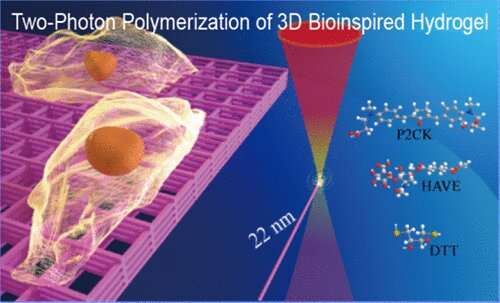Researchers achieve higher precision with biocompatible hydrogel photoresist

Hydrogel materials are widely used due to their excellent biocompatibility. However, the micro- and nanofabrication biomaterials, such as small-diameter artificial blood vessels, flexible biomaterial microdevices, minimally invasive tissue adhesives, and organ and tissue engineering stents, still face the challenge of higher precision.
Prof. Zheng Meiling’s team from the Technical Institute of Physics and Chemistry of the Chinese Academy of Sciences (CAS) developed a biocompatible hydrogel photoresist. In the new strategy, hyaluronic acid vinyl ester (HAVE) is the monomer, cyclopentanone-based material is initiator, and DL-Dithiothreitol is the thiol-ene click chemical cross-linker.
The proposed two-photon polymerization (TPP) of HAVE photoresist strategy leads to a 22 nm resolution. This work was published in ACS Applied Materials & Interfaces on May 23.
In this study, the researchers extensively investigated the TPP of HAVE hydrogel photoresists, and achieved the 22 nm feature size. The photoresist formulation was optimized and the biocompatibility of 3D hydrogel cell scaffolds was explored. The influence of the focus position on the laser threshold was also comprehensively investigated.
Furthermore, the biocompatible 3D hydrogel scaffold structures were fabricated. The protocol proposed in this study is promising for fabricating complex biocompatible 3D hydrogel structures and exploring the potential applications in microenvironment regulation, tissue engineering, biomedicine, and biomimetic science.
More information:
Qi Duan et al, 22 nm Resolution Achieved by Femtosecond Laser Two-Photon Polymerization of a Hyaluronic Acid Vinyl Ester Hydrogel, ACS Applied Materials & Interfaces (2023). DOI: 10.1021/acsami.3c04346
Citation:
Researchers achieve higher precision with biocompatible hydrogel photoresist (2023, June 12)
retrieved 12 June 2023
from https://phys.org/news/2023-06-higher-precision-biocompatible-hydrogel-photoresist.html
This document is subject to copyright. Apart from any fair dealing for the purpose of private study or research, no
part may be reproduced without the written permission. The content is provided for information purposes only.
For all the latest Science News Click Here
For the latest news and updates, follow us on Google News.

